Disclosure: Please note that some links are affiliate links, and at no additional cost to you, we earn a commission if you make a purchase.
If you would like to support this website in some way, using these links will help do exactly that.
While we were climbing to the top of every aviation and boat exhibit we were allowed in the Technik Museum of Speyer, we could see the Cathedral waiting patiently, a jewel box on the horizon. It certainly built the anticipation. The museum and the cathedral are close enough, and Germany is in general pedestrian-friendly enough, that it was an easy, safe walk from one to the other. One weird intersection with crosswalks and a street until you’re in the larger park leading to the cathedral.
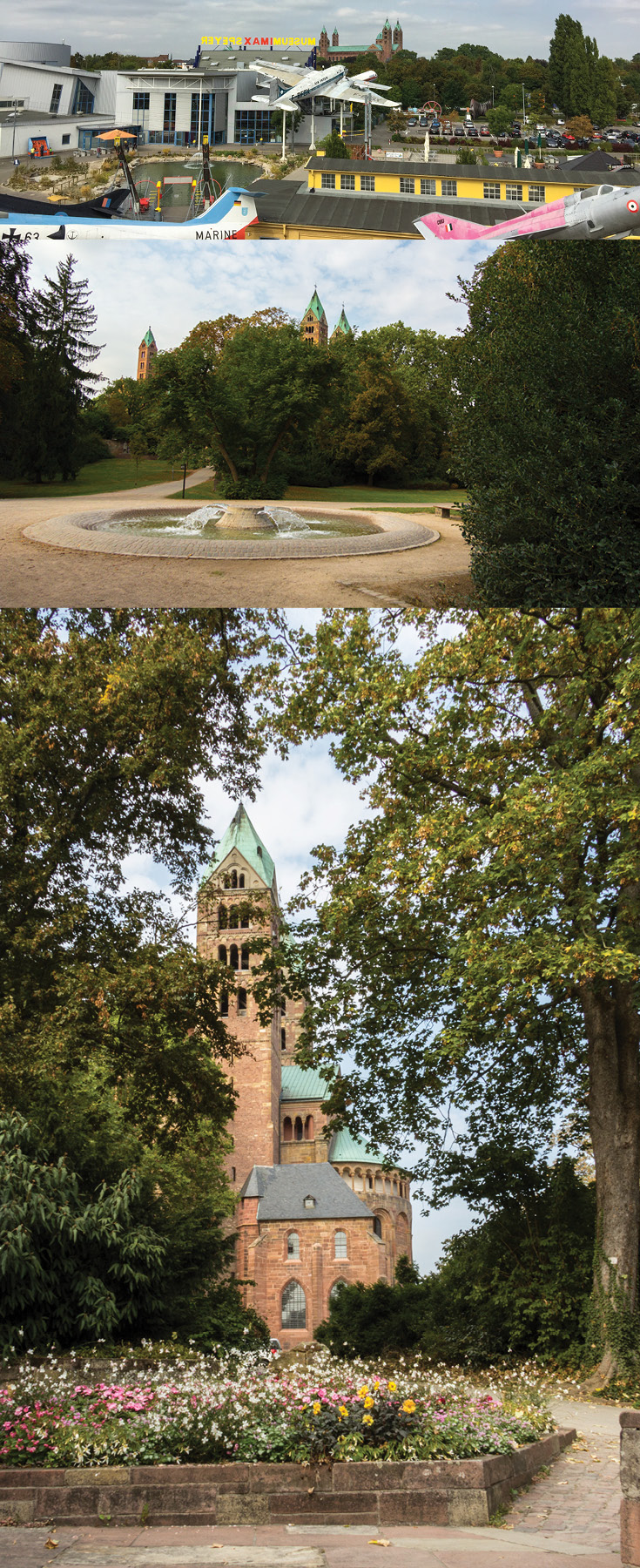
Largest Romanesque Architecture
You could describe this cathedral as so many firsts, largest, best. Being a part of the UNESCO World Heritage List tends to suggest as much. Speyer Cathedral, or Imperial Cathedral of Speyer, Kaiserdom zu Speyer, is the largest example of Romanesque Architecture in the World, the first building constructed entirely from stone in Europe, the first to have an exterior gallery and system of arcades around the entire building, a pilgrimage site, the resting place of 8 Kings and Emperors, and was the biggest church in the western hemisphere at the time of it's completion in 1106. Phew! To say this is a very important building feels like an understatement.
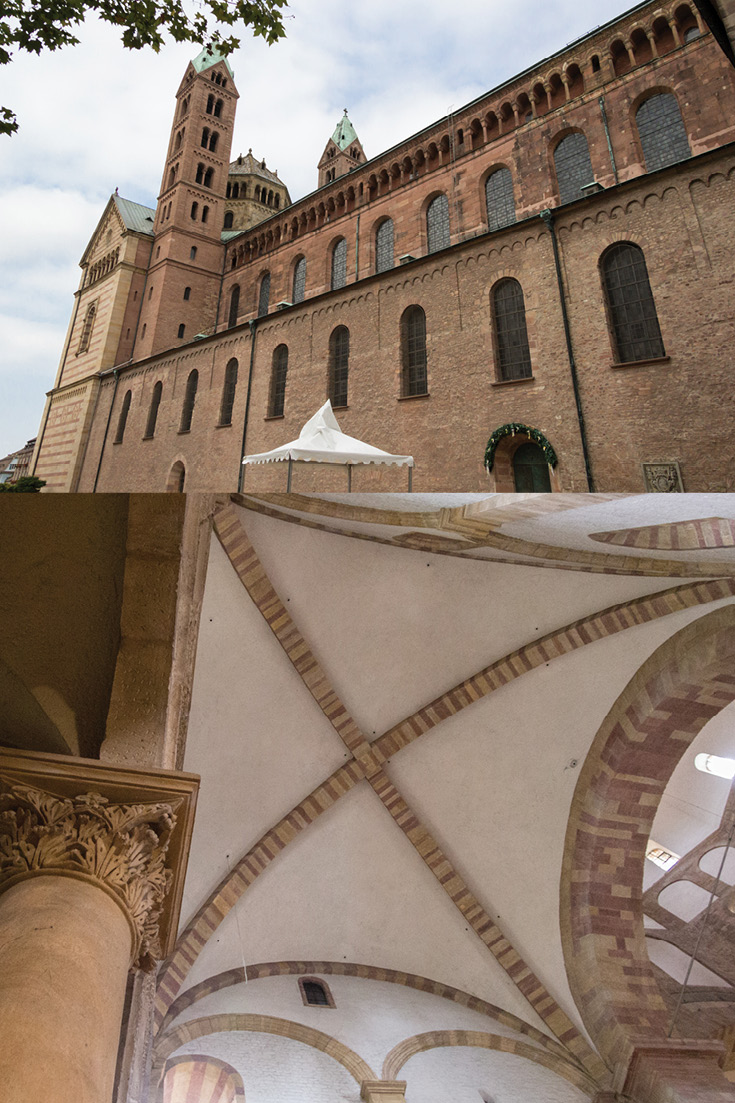
But, how does it make you feel? Personally, it was a calming, solemn, space. Not in anyway creepy as some older European churches are. With minimal ornamentation and varying natural colors shining purely from the carefully placed red sandstone from the nearby Palatine Forest Mountains, this cathedral is the most naturally beautiful church I’ve seen. I have to wonder if the architect Antoni Gaudi hadn’t once visited the Speyer Cathedral? The smooth, soaring semi-circular columns offers the same feeling of being in a quiet forest, just as I had felt in Gaudi’s Sagrada Familia in Barcelona, Spain.
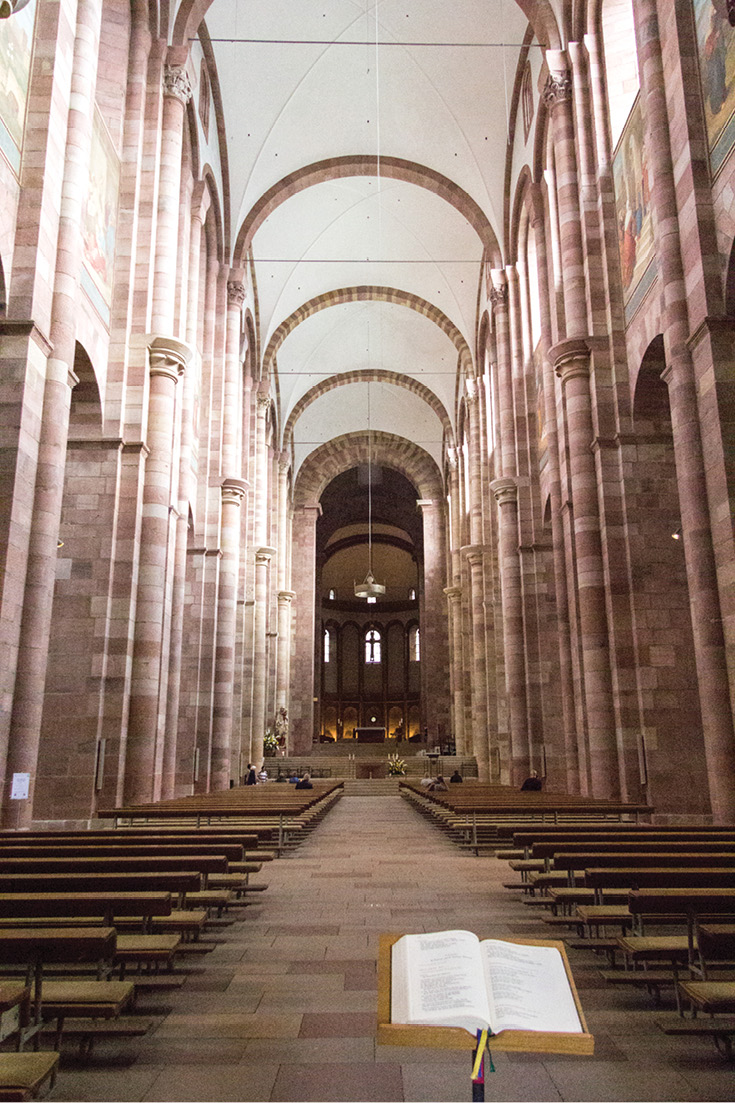
An Image Worthy of a Pilgrimage
A delicate, carefully painted standing Madonna statue quietly demands your attention at the front of the nave with fresh flowers at her feet and candles lit before her. This image, sculpted by German sculptor August Weckbecker, consecrated by Pius XI in Rome, was brought into the Speyer Cathedral in 1930. In doing so, the pilgrimage history for the Speyer Cathedral gained a new chapter to a centuries-long legacy.
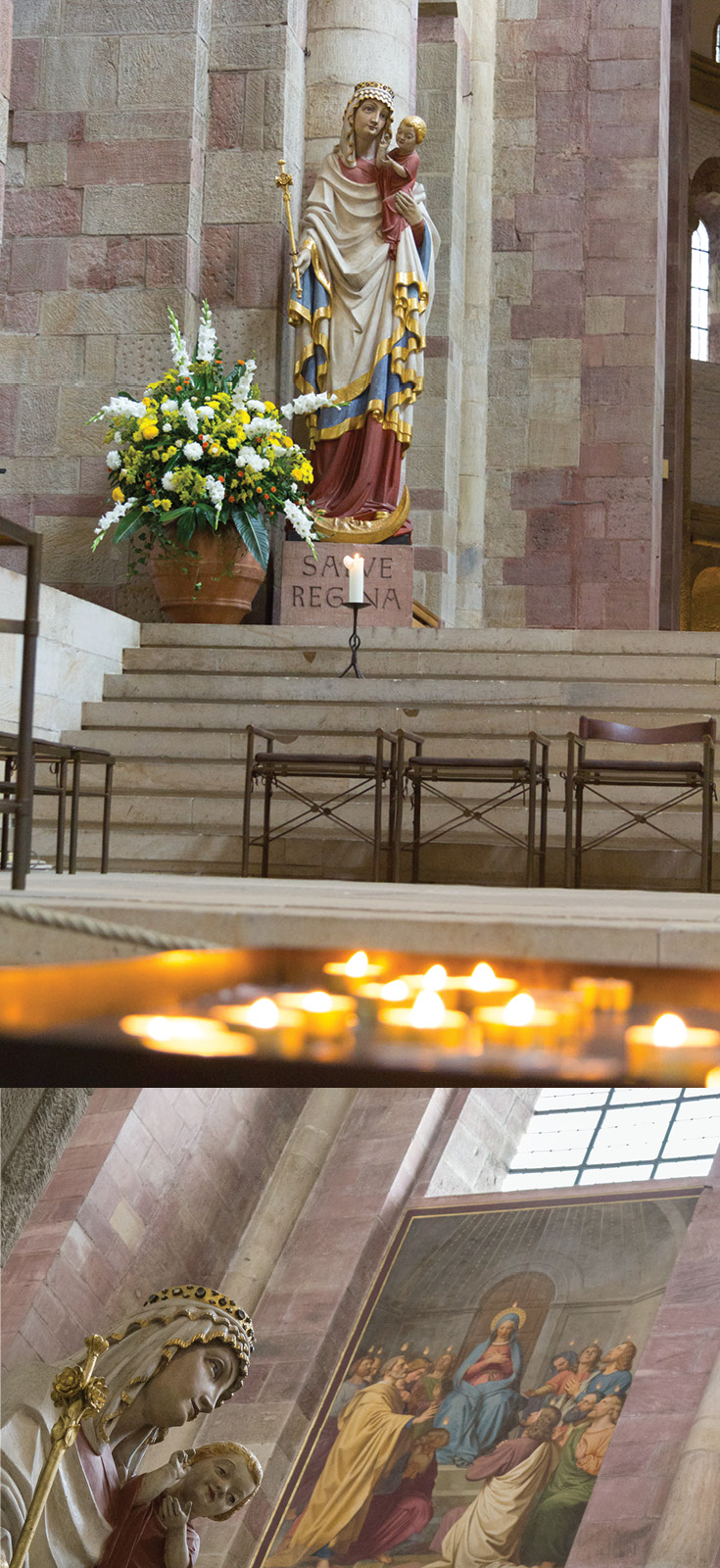
Also in honor of the cathedral's patron saint, the Blessed Mother Mary, along the walls of the nave is a 24-part series depicting Mary’s story painted by Johann von Schraudolph in the mid 1800s. These frescoes were part of an even larger installment and collaboration with Joseph Schwarzmann that was unfortunately removed in the 1960s in an attempt to make the cathedral appear more ‘romanesque.’ Some of the frescoes that were removed have been restored and are now in a new display in the Emperor's Hall of the Cathedral.
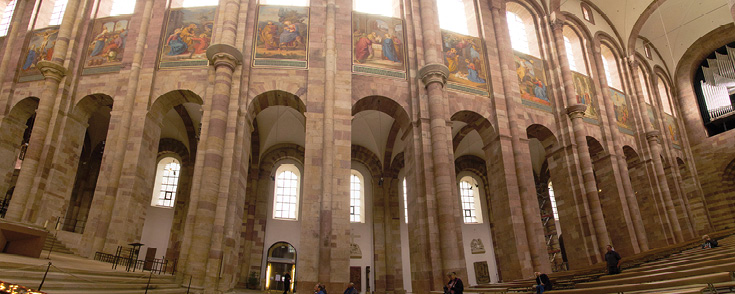
The Mount of Olives
Beside the Cathedral in a leafy clearing, you discover the sculpture ‘The Mount of Olives’, once part of the cloister grounds that were destroyed in the fire of 1689. What survived from Hans Syfer’s original piece was incorporated into the present day replacement by Speyer sculptor Gottfried Renn in 1856. A roof was built above the statue to prevent further wear and tear. Not sure why the roof has a rooster on top. Puzzling, but charming.
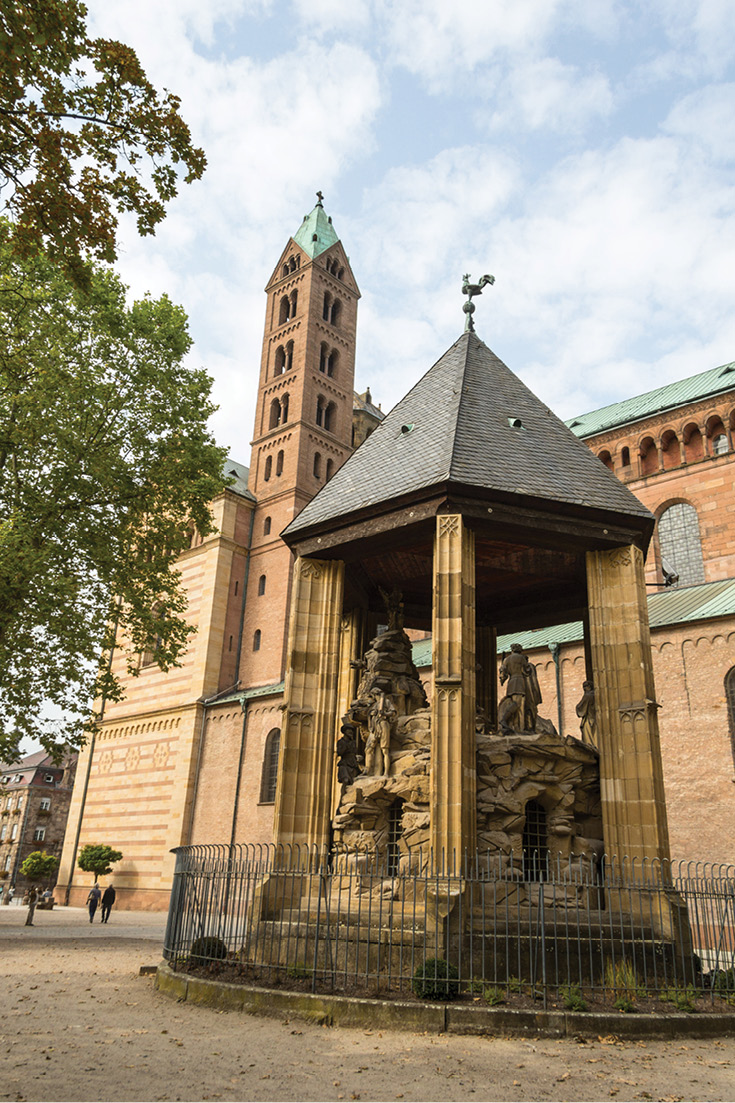
Speyer Cathedral Bowl
Outside the western entrance of the Speyer Cathedral stands the Cathedral Bowl. Many, many years ago it was often used as a loophole for those hoping to escape prison sentences, as the bowl marks the separate bishop and city territories. Prisoners would make a run for the bowl in order to be out of the city's jurisdictional area, now being protected by the church. And historically, to welcome a new bishop, the bowl was filled with wine for the citizens to freely enjoy.
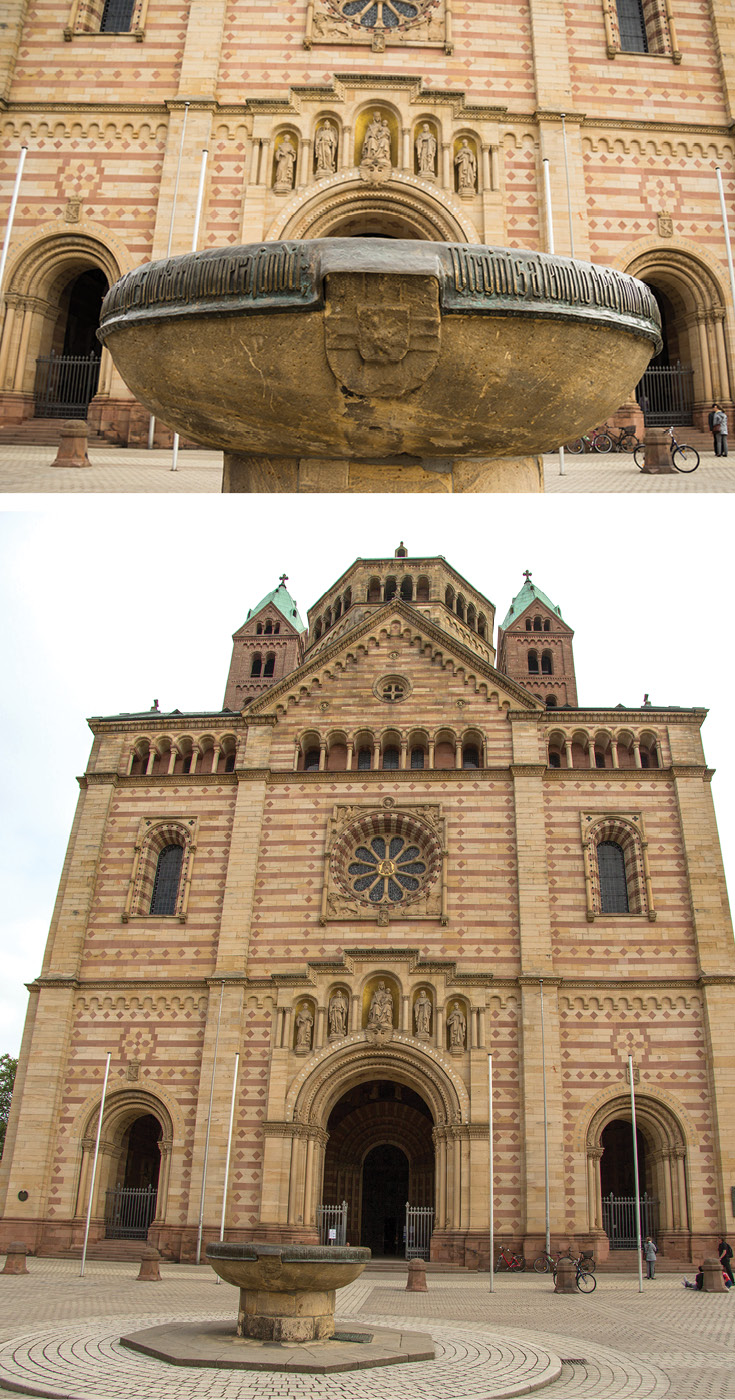
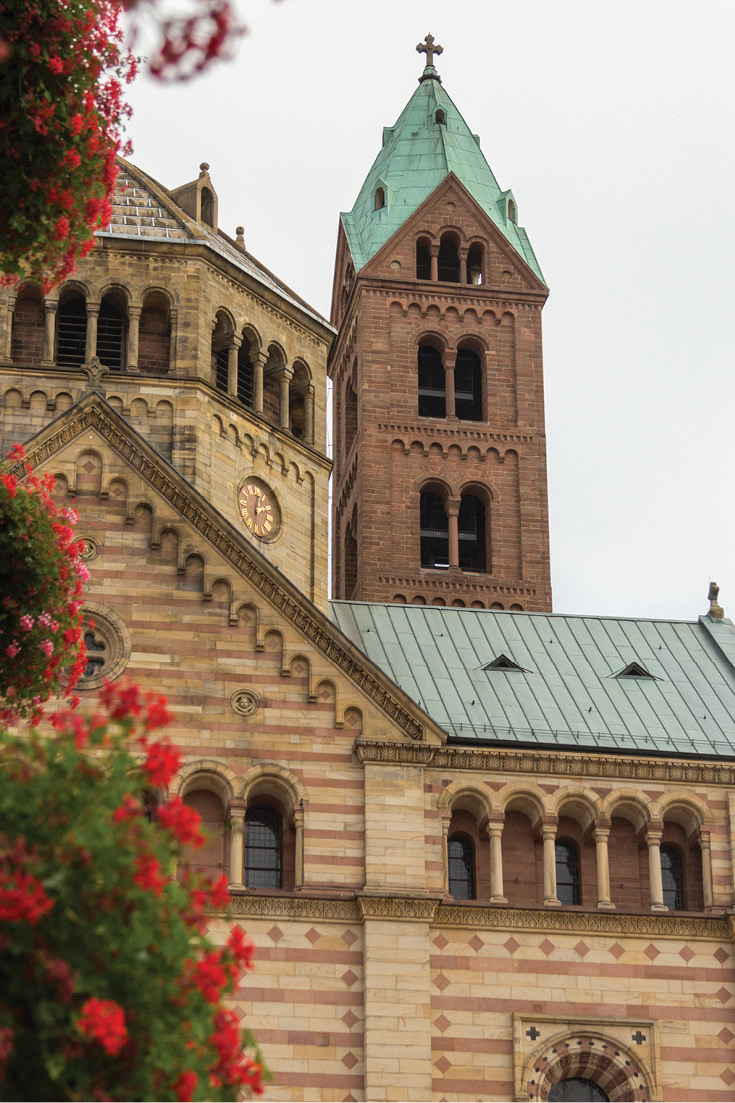
Follow Along
If you enjoyed this article, or these topics sound interesting to you, you'll love our weekly newsletter. You'll receive a free Germany Packing list for signing up, and you'll receive each week's newest posts every Friday. Thank you for reading!

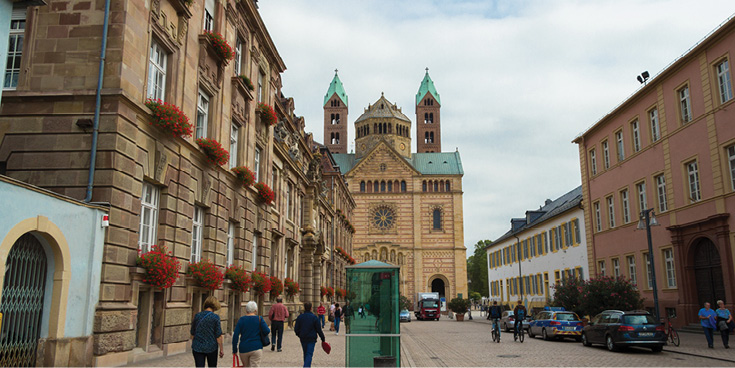
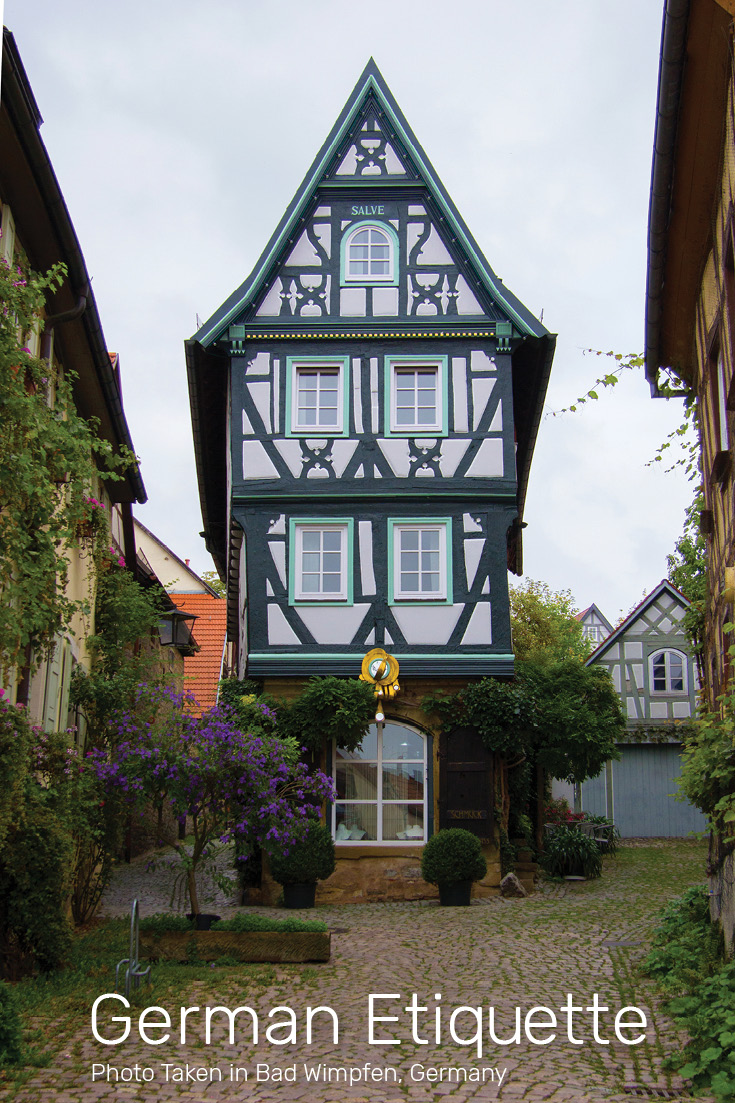
Like any culture in the world, Germans have different customs than you might be used to. To avoid awkwardness and help you feel like a local, here are etiquette tips from someone who grew up in Germany.
Be On Time
There is no translation from German to English for the phrase ‘fashionably late.’ In Germany, or when meeting someone German, you are simply late. Germans tend to be very punctual, and also expect this virtue from others. Basically, don’t be more than a few minutes early and don’t be more than a few minutes late. In my family you get 15 minutes of Karenzzeit, which translates to grace period. If I have to wait 15 minutes or longer past the scheduled time and I do not hear from you, I will most likely leave. So if for some reason you find yourself late to an appointment or a get-together, call to let the person know that you are running late and when you’ll be there.
The exception would be casual parties at a friends house. The more guests there are invited, the wider the window of time is within which it is still appropriate to show up. If the invitation reads that the party starts at 8pm, there are always people that do not show up until later that night.
If you happen to be very early for a get-together, take a stroll through the neighborhood or a nearby park. Nobody wants to show up too early and catch the host while they are trying to get the last items for the party together or take a shower before the big night. This will also give you some extra time to get something to bring for the host, which brings us to my next topic.
Don’t Arrive Empty Handed
When you are invited to a private house or home in Germany, be it for a fancy dinner or for casual afternoon Kaffee und Kuchen, it's a always a good idea to bring a small gift for the host or hostess. The easiest are flowers with an odd number of buds, as an even number is said to bring bad luck. Also, take any plastic covering or wrapping off the flowers before arriving. When selecting flowers, try to avoid red roses, which symbolize love, or lilies and carnations, which are common for German funerals. If you do not want to bring flowers, candy or wine is also appropriate. Basically, do not show up empty handed and expect them to feed and fawn all over you.
Now that you are on time and you have a small gift, what happens next?
Greeting Germans
Germans can be weird when it comes to greetings. We alter our greetings depending on how well we know the other person. If you are being introduced to a person for the first time, expect a handshake. Make sure your hand is dry, look them in the eyes and have a firm handshake. Don’t break their hand, but also do not just lay your hand onto theirs. Germans like firm handshakes. When joining a group, it is very common for a person to shake hands with every single individual.
Once you know the person better (and you are in a non-business setting), Germans will take the greeting up a notch and replace the handshake with kissing on the cheeks, one on the left and one on the right. This is often shocking for Americans, who anticipate that its going to be a hug exchange and end up with a kiss on the cheek, but then upon releasing Americans anticipate the greeting is over, only to be pulled in for a second round on the other side. If you end up in Switzerland, three cheek kisses are customary. Yesterday it was handshakes. Today its cheek kisses.
If in doubt, let the German make the first move and be prepared for both. Nothing is worse than leaning in for a cheek kiss and running into their hand that is out for a formal handshake.
Now that you are inside and have greeted everyone, there is some drinking etiquette to be aware of.
Drinking with Germans
When you toast and clink glasses in Germany, say "Zum Wohl" (good health) or "Prost" (cheers) before drinking. Also, make sure to look the person you are toasting into his or her eyes. Otherwise both of you will have seven years of poor intimacy, if you know what I mean.
“Guten Appetit” is said before eating and means enjoy your meal. Wait until everyone has their meal in front of them before you start and respond to the host’s “Guten Appetit” by repeating the same greeting or answering “Danke, ebenfalls” (Thanks, you too).
And one more bonus tip for you to look out for:
Germans Recycle...Intensely
Trash is usually separated in Germany, in private homes and in public bins as well. Many Germans take recycling seriously and ignorance of or indifference to this practice may be frowned upon.
You will find separate disposal areas for glass, paper and packaging in airports and train stations. In private homes we usually have a separate container for organic waste, such as coffee grinds and food leftovers plus separate plastic and paper trash containers. While recycling in the United States often only goes into one container and then gets sorted at the recycling facility, Germans separate their recycling at home already and pay attention to the different recycling pickup days. They also return bottles and cans in order to receive their deposit back, learn more about this process, called Pfand in our previous article.
Am I missing something? Do you have any additions to German etiquette? Leave a comment or send us an email.Follow Along
If you enjoyed this article, or these topics sound interesting to you, you'll love our weekly newsletter. You'll receive a free Germany Packing list for signing up, and you'll receive each week's newest posts every Friday. Thank you for reading!

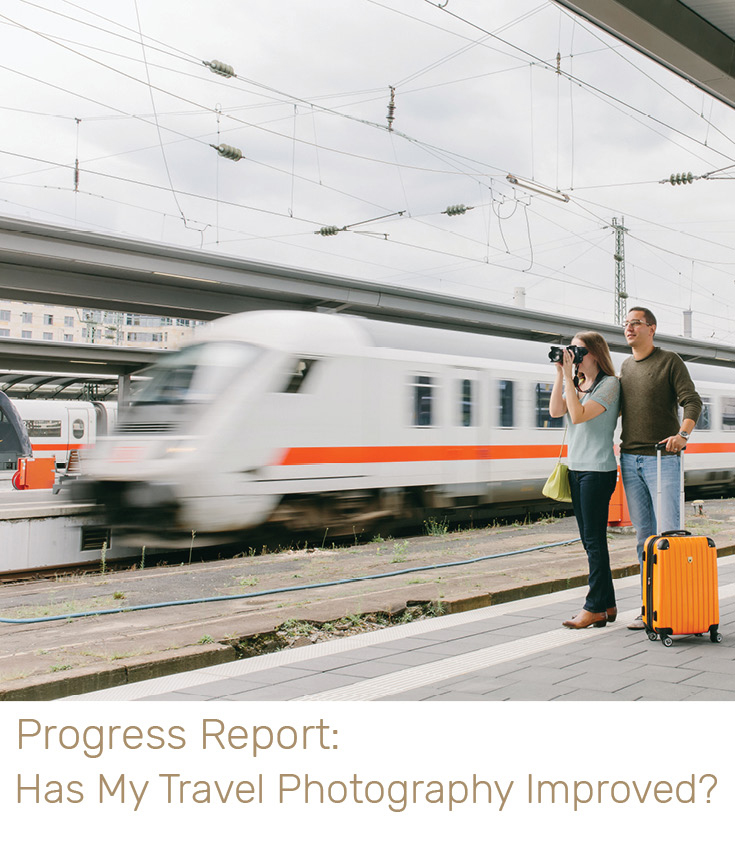
**This post contains affiliate links and I will be compensated if you make a purchase after clicking on my links. This is at no additional cost to you.
I ended up postponing this progress report until after we made our second trip for Christmas in Germany, and I’m really glad I did. I’m proud to say I have made definite progress both in keeping my architecture shots from becoming distorted, in incorporating tourists purposefully into my shots, and being mindful of visual merging. If you’re scratching your head, this is the 4th and final post in a series about learning and improving travel photography from a CreativeLive Class Travel Photography: The Complete Guide with Ben Willmore. If you missed them, here’s where you can get caught up:
Back? Ready? Ok!
Is That Building Falling? Or Is It Me?
I tried to break my bad habit of tilting my camera up at a building when shooting architecture. Being short, this was a tough one. I tried to instead get more than one side of the building so short buildings didn’t appear to be falling backwards. I had really good luck with this technique when visiting the World Unesco Heritage Pile Dwelling Site in Uhldingen-Mühlhofen.
When I had to shoot up at the building, like with this shot of the Dom in Konstanz, I embraced it and tried to make the viewer feel like an ant looking up at this towering facade, which is how I felt at the time.
Using Tourists To My Advantage
Out of my four favorite tips that Willmore suggested for dealing with tourists, I was easily able to implement #1, using the tourist to your advantage through their presence physically adding color or their placement in the composition. While at the Liebieghaus in Frankfurt am Main after Christmas, I was shooting the outside architecture of the museum. It was an overcast, blah-December-day, and a woman started walking towards the entrance, dressed in black with a red shawl. I wanted to hug her. It was just the pop of color I needed and of course her presence also provided nice scale comparison to the building itself. To read about my other 3 favorite tips dealing with tourists in your shots, review part 3 again.
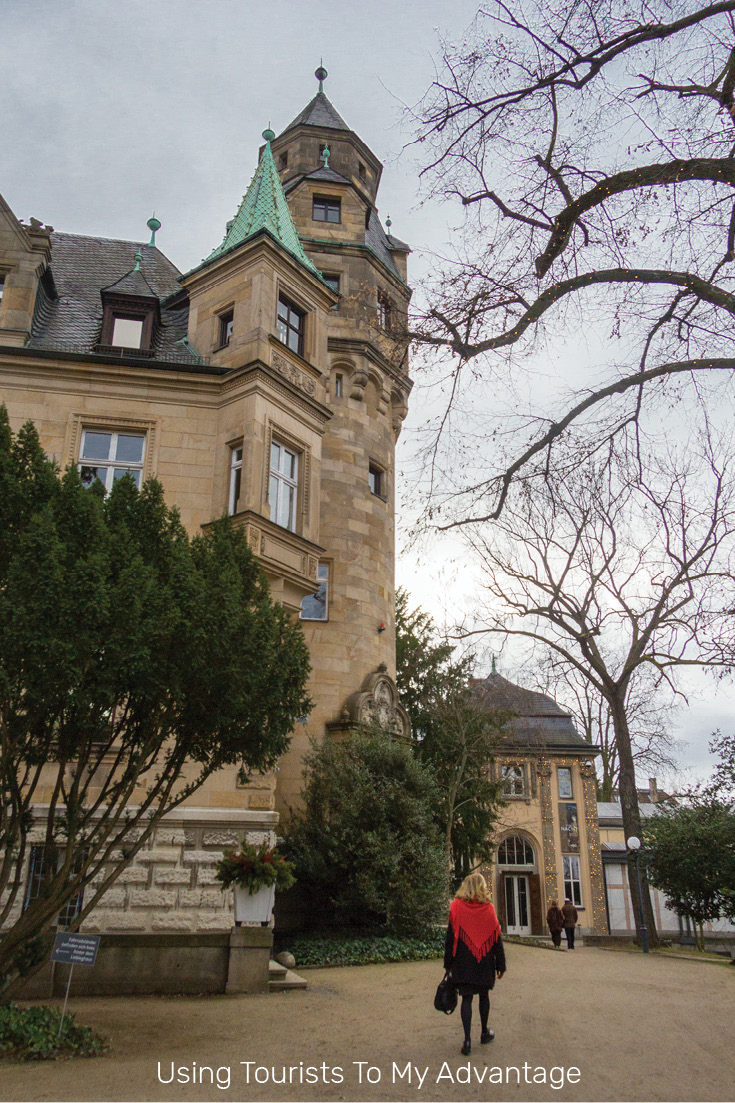
Visual Merging Fountain in Bodensee
After learning about ‘Visual Merging’, which is where objects in the foreground visually combines in your composition with your background, I made a concerted effort to look for merging when shooting sculptures. While in Lindau on Lake Bodensee, we hunted for a fountain that had come highly recommended by a museum volunteer. Upon finding it, I tried shooting various angles of it, always looking to see if anything was merging into the background. This is the first, initial photo I took.
I wanted the focus to be on the top statue, and here the foliage behind it are visually merging in a distracting, busy way. I wandered around to the opposite side, where I could get more separation between the figure and the foliage.
Ninja-Phantom Lightroom Presets
Wow. Just wow. In part 2, I mentioned that when you purchase the class, you get a gigantic set of Ben’s tried-and-tested presets, and even includes a 2-page PDF with screenshots of how to install them. Having them has sped up my editing, as well as taught me additional tricks in Lightroom. Do you need your blue sky about 25% brighter? He’s got a preset for that, in percentage increments of 25. Willmore is so specific with his sorting of presets, if I have an issue with an image, I can easily navigate to the right folder and find a few presets that thanks to their naming, I know I can try to solve my problem. By doing so, the assigned settings are applied and you can literally see what tool sliders he adjusted, learning more about how Lightroom’s tools can be used in the process.
App? APP!!
Since I began this series, CreativeLive now offers an app in iTunes, compatible with iPhone, iPad, iPod, and AppleTv. The convenience factor of Creative Live has increased 10 fold. It's free to download, and you have access to all of the channels live streaming. After purchasing classes, you can access the episodes directly on the app as well, and it remembers where you left off.


